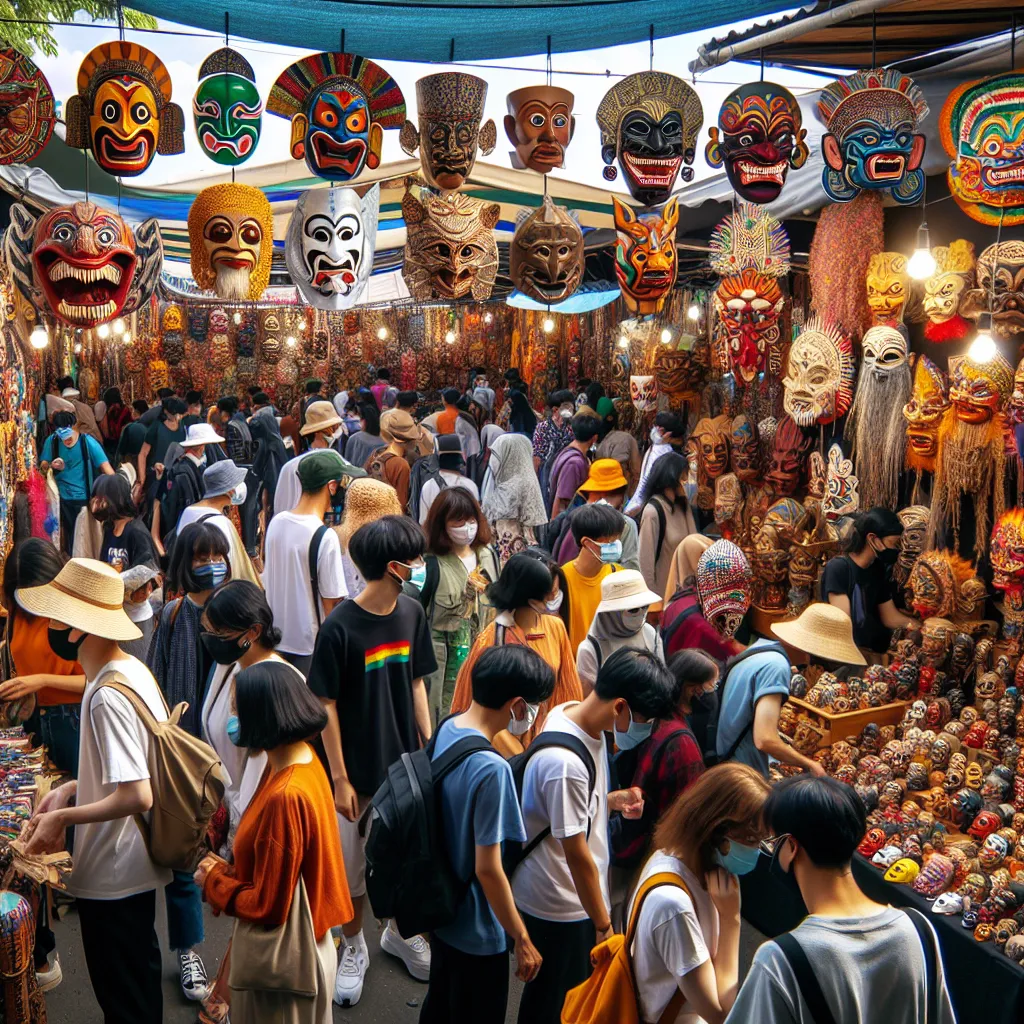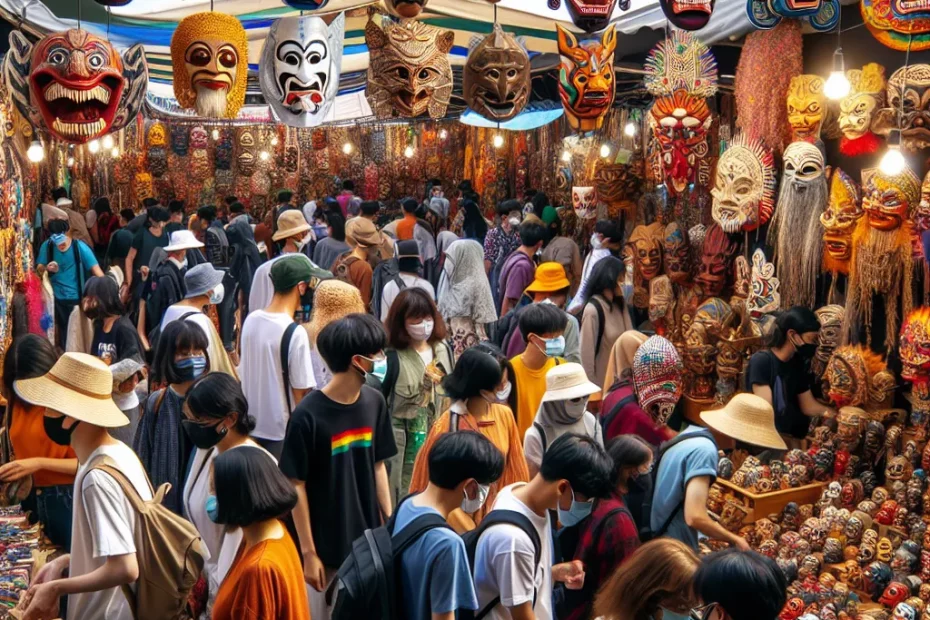The Andong International Mask Dance Festival is a celebration of the rich cultural heritage of masked dance from various corners of the globe. This annual event brings together artists, performers, and spectators to immerse themselves in the beauty and artistry of masked dance traditions. Exploring the intricate history of masked dance, the festival showcases diverse cultural representations through mesmerizing performances. From the elaborate techniques and styles in mask making to the profound impact of mask dance festivals on global cultural exchange, this event serves as a vibrant tapestry of creativity and tradition. Join us on this captivating journey as we delve into the fascinating world of masked dance at the Andong International Mask Dance Festival.

Exploring the History of Masked Dance
The history of masked dance dates back centuries, with cultures around the world embracing this unique art form as a way to celebrate, entertain, and communicate. From traditional rituals to theatrical performances, masked dance has played a significant role in various societies, offering a glimpse into the rich tapestry of human expression and creativity.
Role of Masked Dance in Religious Ceremonies
In many cultures, masked dance has been used in religious ceremonies to honor gods and ancestors, as well as to ward off evil spirits. The masks themselves are often intricately designed, each symbolizing different deities, animals, or mythical beings. Through the movements and gestures of the dancers, stories and legends are brought to life, captivating audiences and preserving cultural heritage.
Korean “Hahoe Byeolsin Exorcism Dance”
One of the most well-known examples of masked dance is the Korean “Hahoe Byeolsin Exorcism Dance,” which has been designated as a UNESCO Intangible Cultural Heritage. This ancient ritual, performed in the village of Hahoe in Andong, South Korea, combines music, dance, and drama to exorcise evil spirits and bring blessings to the community. The performers wear colorful masks representing various characters, each with its own personality and role in the performance.
Traditional Masked Dances in Africa
In Africa, traditional masked dances are an integral part of many tribal ceremonies, such as initiation rites, harvest celebrations, and storytelling events. The masks are believed to embody the spirits of ancestors, animals, or natural forces, serving as a link between the physical and spiritual worlds. Through rhythmic movements and chants, the dancers convey messages of wisdom, unity, and cultural identity.
Evolution of Masked Dance in Contemporary Performing Arts
Masked dance has also found its way into contemporary performing arts, with modern choreographers and artists incorporating traditional elements into innovative productions. By blending old and new techniques, these performances continue to evolve, attracting audiences from diverse backgrounds and fostering cross-cultural understanding.
As we explore the history of masked dance, we discover a world of creativity, symbolism, and tradition that transcends time and borders. Whether rooted in ancient rituals or reimagined for the modern stage, masked dance remains a vibrant and captivating art form that celebrates the human spirit in all its diversity and expression. Let us continue to cherish and preserve this cultural treasure for generations to come! 🎭🌍✨
Diverse Cultural Representations in Masked Dance
Masked dance is a fascinating art form that transcends borders and cultures, showcasing the rich diversity of traditions and storytelling techniques from around the world. One of the most renowned celebrations of this art form is the Andong International Mask Dance Festival, where performers from various countries come together to share their unique masked dance traditions with a global audience. This festival serves as a melting pot of cultural exchange, highlighting the beauty and significance of masked dance in different societies.
Distinct Cultural Representations
The Andong International Mask Dance Festival features a wide array of performances, each representing a distinct cultural heritage. From the intricate wooden masks of Korea to the vibrant feathered masks of South America, the festival offers a glimpse into the unique artistic expressions of different regions. The diversity of styles and themes showcased at the festival underscores the universal appeal of masked dance as a form of cultural expression.
Global Exchange of Traditions
With over 20 countries participating in the festival, visitors have the opportunity to witness a kaleidoscope of traditions, each with its own symbolism and narrative. The fusion of traditional and contemporary elements in the performances adds a dynamic layer to the cultural exchange, creating a truly immersive experience for spectators. Through the language of movement and music, performers convey stories of love, loss, triumph, and transformation, captivating audiences of all ages.
Cross-Cultural Dialogue and Preservation
The festival also serves as a platform for artists to engage in cross-cultural dialogue, fostering mutual understanding and appreciation for diverse artistic practices. Workshops, seminars, and collaborative performances allow participants to learn from one another, creating lasting connections that extend beyond the festival grounds. This exchange of ideas and techniques not only enriches the artistic community but also promotes cultural diplomacy and global solidarity.
Preservation of Traditional Art Forms
In addition to its cultural significance, the Andong International Mask Dance Festival plays a vital role in preserving and promoting traditional art forms. By showcasing masked dance traditions from around the world, the festival raises awareness about the importance of safeguarding intangible cultural heritage. Through education and outreach programs, the festival seeks to ensure the continuity of these ancient practices for future generations to enjoy and learn from.
Celebration of Diversity and Creativity
As a celebration of diversity and creativity, the Andong International Mask Dance Festival stands as a testament to the power of cultural exchange and artistic expression. By bringing together performers and audiences from different backgrounds, the festival creates a space for dialogue, discovery, and mutual respect. In a world that is increasingly interconnected, events like the Andong International Mask Dance Festival remind us of the beauty and value of our shared cultural heritage. Let’s celebrate the art of masked dance and the vibrant tapestry of cultures that it represents! 🎭🌍
Techniques and Styles in Mask Making
In the world of mask making, various techniques and styles have been developed over centuries, showcasing the rich cultural heritage and artistic expressions of different regions. From traditional methods passed down through generations to contemporary innovations, mask makers employ a wide range of skills to create stunning pieces of art that captivate audiences worldwide.
Traditional Techniques:
One of the most fascinating aspects of mask making is the use of traditional techniques that have been preserved and refined over time. Artisans often rely on hand-carving, a meticulous process that involves shaping raw materials such as wood, clay, or leather into intricate designs. This hands-on approach not only requires precision and patience but also allows for a deep connection to the cultural roots of the craft.
Painting and Decoration:
Once the basic form of the mask is crafted, the next step is painting and decoration. This stage is where the mask truly comes to life, as artists use a variety of colors, patterns, and textures to convey different emotions and meanings. Whether it’s vibrant hues for festive celebrations or subtle shades for dramatic performances, the art of painting plays a crucial role in enhancing the beauty and symbolism of the mask.
Detailing and Finishing:
Attention to detail is key in mask making, with artisans focusing on every aspect of the design to ensure a flawless finish. Intricate patterns, delicate engravings, and embellishments such as feathers, beads, or shells are added to create a visually stunning piece that captures the essence of the character or story being portrayed. The final touches often involve a meticulous process of polishing, varnishing, or aging the mask to achieve the desired effect.
Regional Styles:
Across different cultures and regions, unique styles of mask making have emerged, each reflecting the traditions, beliefs, and aesthetics of the community. From the bold and colorful masks of Latin America to the elegant and minimalist designs of East Asia, every culture brings its own flair to this ancient art form. Exploring these diverse styles not only offers a glimpse into the cultural diversity of the world but also highlights the universal appeal of masked dance as a form of storytelling and expression.
Innovations and Contemporary Trends:
While traditional techniques remain at the core of mask making, modern artisans are also exploring new materials, technologies, and artistic concepts to push the boundaries of the craft. 3D printing, digital design tools, and interdisciplinary collaborations are reshaping the way masks are created and presented, opening up exciting possibilities for innovation and experimentation in the field.
From the intricate hand-carving of traditional masks to the cutting-edge techniques of contemporary artists, the world of mask making continues to evolve, blending heritage with innovation to create timeless works of art that transcend cultural boundaries and inspire awe and wonder in audiences around the globe.
Impact of Mask Dance Festivals on Global Cultural Exchange
The Andong International Mask Dance Festival stands as a shining example of how mask dance festivals have a profound impact on global cultural exchange. This vibrant festival, held annually in South Korea, brings together artists and performers from around the world to celebrate the rich tradition of masked dance. With over 10,000 participants and more than 1 million attendees each year, this festival serves as a melting pot of diverse cultures, fostering cross-cultural understanding and appreciation.
Role of Mask Dance Festivals in Cultural Diplomacy
Mask dance festivals play a crucial role in promoting cultural diplomacy and fostering international cooperation. By showcasing traditional masked dances from different countries, these festivals create a platform for cultural exchange and dialogue. Through the universal language of dance, artists and audiences alike can connect on a deeper level, transcending linguistic and cultural barriers. This cultural exchange not only enriches the participants but also promotes mutual respect and appreciation for diverse cultural heritage.
Global Impact of Mask Dance Festivals
The impact of mask dance festivals on global cultural exchange can be seen in the numbers. According to recent studies, attendance at mask dance festivals has been steadily increasing, with a significant rise in international visitors. This influx of global participants not only boosts the local economy but also promotes cultural tourism and exchange. In addition, the media coverage and online presence of these festivals have expanded their reach, attracting a wider audience and creating a ripple effect of cultural appreciation worldwide.
Platform for International Artists
Furthermore, mask dance festivals serve as a platform for artists to showcase their talent on an international stage. Through performances, workshops, and collaborative projects, artists have the opportunity to share their unique cultural heritage with a global audience. This exposure not only helps preserve traditional art forms but also encourages innovation and creativity in mask dance performances.
In conclusion, the impact of mask dance festivals on global cultural exchange cannot be overstated. These festivals serve as bridges that connect people from different backgrounds, fostering mutual understanding, respect, and appreciation for diverse cultures. As we continue to celebrate the art of masked dance from around the world, let us remember the profound impact it has on promoting cultural exchange and building a more interconnected and harmonious global community. Let the masks dance, and let the world unite in celebration of our shared cultural heritage! 🎭🌍
The Andong International Mask Dance Festival is a celebration of diverse cultures coming together through the art of masked dance. By exploring the rich history of masked dance, we gain a deeper appreciation for the traditions and stories behind each performance. The festival showcases a wide range of cultural representations, highlighting the unique styles and techniques used in mask making from around the world. Through events like this, we can witness the profound impact of mask dance festivals on global cultural exchange, fostering understanding and appreciation among different communities. As we immerse ourselves in the vibrant colors, intricate designs, and mesmerizing movements of masked dances, we are reminded of the beauty and power of cultural heritage in uniting people across borders.
